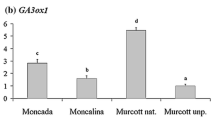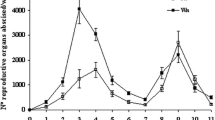Summary
Gibberellins were extracted from seeds and green plants of different sex types of the closely related species Cucumis sativus L. (cucumber) and C. melo L. (muskmelon). Both seeds and green plants of monoecious and andromonoecious lines of C. sativus contained significantly higher gibberellin levels at all growth stages tested than did a gynoecious line. Gibberellin activity in the monoecious and andromonoecious C. sativus line reached a maximum at the growth stage corresponding to flower differentiation at cotyledonary and first leaf axils. Vernalization of seeds of gynoecious plants resulted in increased male tendency correlated with increased gibberellin activity. In contrast, monoecious and andromonoecious lines of C. melo were gibberellin deficient relative to hermaphroditic and gynoecious lines.
Similar content being viewed by others
References
Atsmon, D. & Galun, E. 1960. A morphogenic study of staminate, pistillate, and hermaphroditic flowers in Cucumis sativus L. Phytomorphology 10:110–115.
Atsmon, D., A., Lang & Light, E. N., 1968. Contents and recovery of gibberellins in monoecious and gynoecious cucumber plants. Pl. Physiol. 43: 806–810.
Clark, R. K. & Kenney, D. S., 1969. Comparison of staminate flower production on gynoecious strains of cucumbers, Cucumis sativus L., by pure gibberellins (A3, A4, A7, A13) and mixtures. J. Am. Soc. hort. Sci. 94:131–132.
Galun, E., 1959. Effects of gibberellic acid and α-naphthaleneacetic acid on sex expression and some morphological characters in the cucumber plant. Phyton 13:1–8.
Hayase, H. & Tanaka, M., 1967. Induction of staminate flowers in the gynoecious MSU 713–5 by application of gibberellin and (2-chloroethyl) trimethylammonium chloride (CCC) simultaneously or alternately. Hokkaido Nogyo Shikensho Iho (Japan) 91:26–30.
Hayashi, F., Blumenthal-Goldschmidt, S. & Rappaport, L., 1962. Acid and neutral gibberellin-like substances in potato tubers. Pl. Physiol. 37:774–780.
Hayashi, F., Sell, H. M. & Peterson, C. E., 1967. Gibberellin content of monoecious and gynoecious cucumber. Abstr. 7th Int. Congr. Biochem. J-180, Tokyo.
Hayashi, F., Boerner, D., Peterson, C. E. & Sell, H. M., 1971. The relative content of gibberellin in seedlings of gynoecious and monoecious cucumber (Cucumis sativus). Phytochemistry 10:57–62.
Jones, R. & Varner, J., 1967. The bioassay of gibberellins. Planta 72:155–161.
Kubicki, B., 1966. Genetic basis for obtaining gynoecious muskmelon lines and the possibility of their use for hybrid seed production. Genet. Pol. 7:27–29.
Kubicki, B., 1969. Comparative studies on sex determination in cucumber (Cucumis sativus L.) and muskmelon (Cucumis melo L.). Genet. Pol. 10:167–183.
Mishra, R. & Pradhan, B., 1970. Effect of (2-chloroethyl)-trimethylammonium chloride on sex expression in cucumber. J. hort. Sci. 45:29–31.
Peterson, C. E., 1960. A gynoecious inbred line of cucumber. Q. Bull. Mich. agric. Exp. Stn 43:40–42.
Peterson, C. E., 1963. Gynoecious muskmelons for hybrid seed production. Abstr. 60th Ann. Meet. Am. Soc. hort. Sci. 332 (Amherst, Massachusetts).
Peterson, C. E. & Anhder, L., 1960. Induction of staminate flowers on gynoecious cucumbers with gibberellin A3. Science 131:1673–1674.
Phinney, B. O. 1956. Growth response of single-gene dwarf mutants in maize to gibberellic acid. Proc. natn. Acad. Sci. USA 42: 185–189.
Pike, L. M. & Peterson, C. E., 1969. Gibberellin A4/A7 for induction of staminate flowers on the gynoecious cucumber (Cucumis sativus). Euphytica 18:106–09.
Wittwer, S H., & Bukovac, M. J., 1962. Staminate flower formation on gynoecious cucumbers as influenced by the various gibberellins. Naturwissenchaften 49:305–306.
Author information
Authors and Affiliations
Additional information
Journal Article No 5534 from the Michigan Agricultural Experiment Station. This work was supported by a grant from the Herman Frasch Foundation.
Rights and permissions
About this article
Cite this article
Hemphill, D.D., Baker, L.R. & Sell, H.M. Different sex phenotypes of Cucumis sativus L. and C. melo L. and their endogenous gibberellin activity. Euphytica 21, 285–291 (1972). https://doi.org/10.1007/BF00036769
Received:
Issue Date:
DOI: https://doi.org/10.1007/BF00036769




